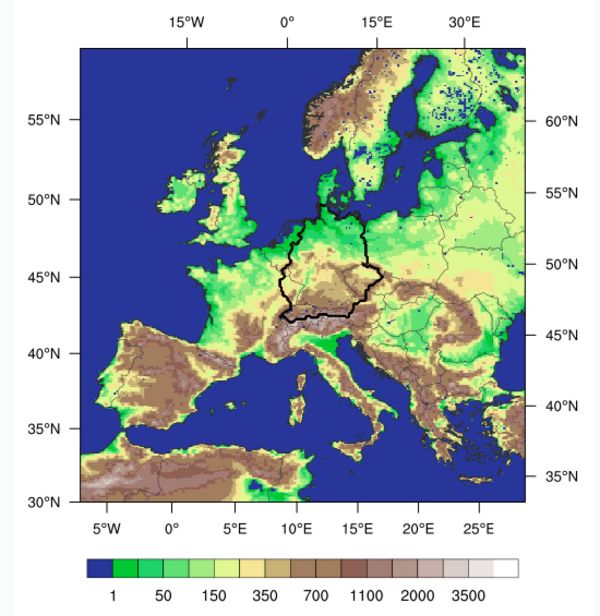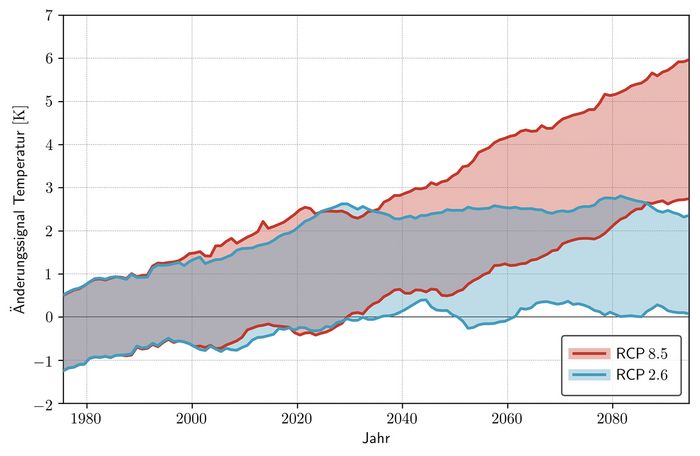ENVIRONMENT AND ENERGY
Climate Change Studies for Germany
Principal Investigator:
Kirsten Warrach-Sagi
Affiliation:
University of Hohenheim (Germany)
Local Project ID:
WRFCLIM
HPC Platform used:
Hazel Hen of HLRS
Date published:
The University of Hohenheim contributed with five regional climate simulations to the multi-model ensemble of EURO-CORDEX. The ensemble data is required to analyze the climate change signals in Europe and to provide high-resolution products for climate impact research and politics for 1971 to 2100.
Anthropogenic climate change is observable worldwide. This is mainly due to the emission of greenhouse gases caused by human activities. Since warming over many land areas is larger than over the oceans, climate change will be highly variable. Mitigation and adaptation strategies require regional climate simulations for the 21st century based on emission scenarios. In order to estimate the accuracy of regional climate projections, multi-model ensembles1 are required. A particularly large ensemble was realized in the COordinated Regional climate Downscaling EXperiment CORDEX initiated by the World Climate Research Program. Global climate projections of the Coupled Model Intercomparison Project Phase 5 (CMIP5, www.wcrp-climate.org/wgcm-cmip/wgcm-cmip5) were downscaled to 50-km or 12-km resolving grids for each continent. The CMIP5 global climate simulations were the baseline model data evaluated in the 5th assessment report on climate change by the Intergovernmental Panel of Climate Change in 2013 (IPCC, 2014).
1 Ensemble: A collection of model simulations characterizing the accuracy and uncertainty of climate projections. Differences in initial conditions and model formulations result in different evolutions of the model outputs and provide information on uncertainty associated with model error and errors in initial conditions as well as internally generated climate variability. (IPCC, 2014)
From 2014 to 2017, the Federal Ministry of Education and Research (BMBF) funded the project “Regionale Klimasimulationen Ensemble für Deutschland” (ReKliEs-De, reklies.hlnug.de) to downscale CMIP5 global climate model data to a 12 km resolving grid for Germany and its river contributories (Fig. 1) for the simulation time period 1958 to 2100 and to provide climate indices for analyses, impact research and consultation (Hübener et al., 2017a,b). We contributed to the multi-model ensemble by downscaling five CMIP5 simulations with the Weather and Research Forecasting (WRF) model (Skamarock et al., 2008) using the CRAY XE6 and XC40 supercomputers from summer 2016 to autumn 2017 (e.g., Bönisch et al., 2017). Each simulation required 3600 hours walltime on 5400 cores and produced 400 TB raw output data. Due to the excellent HLRS infrastructure, it was possible to run the five WRF simulations in parallel, i.e. 27000 core hours per job. Details of the simulations are reported by Warrach-Sagi et al. (2019).
“The ensemble members give much better confidence in the estimation of the evolution of medians of atmospheric variables due to climate change as well as in the estimation of extreme values such as hot and ice days than in single model runs. The corresponding climate indices provided by ReKliEs-De underline the importance for society and economy to mitigate climate change. In the “business as usual” scenario (RCP 8.5) the results reveal for Germany an increase of the annual mean temperature by 4°C (ensemble bandwidth of 2.8 to 5°C) at the end of this century in comparison with the end of the 20th century (Fig. 2). This implies a significant increase of heat days (maximum temperature above 30°C) and decrease of frost days (minimum temperature below 0°C) [..] In Germany, winter precipitation will increase and due to the warming this will be rather rain than snow. […]
In case of the climate protection scenario (RCP2.6), the increase would only be 1°C (bandwidth of 0,7 to 2,4 °C) with a corresponding reduction of the number of extreme events. The strong difference in the evolution of mean temperature is demonstrated in Figure 2. Obviously, the RCP8.5 must be considered as very dangerous for the society whereas the RCP2.6 scenario will lead to an increase of temperature, which would be in line with the goals of the Paris Agreement in 2015. Therefore, the ReKliEs-De results do not only contain information for adaptation in different areas such as hydrology and agriculture but also have political implications for decision makers.” (Warrach-Sagi et al., 2019).
At the University of Hohenheim the climate data is currently under investigation in the frame of climate change impact on agriculture.
Researchers
Viktoria Mohr, Kirsten Warrach-Sagi (PI), Volker Wulfmeyer
References:
Bönisch, T., M. Resch, T. Schwitalla, M. Meinke, V. Wulfmeyer, K. Warrach-Sagi, 2017: Hazel Hen – Leading HPC technology and its impact on science in Germany and Europe, Parallel Computing, 64, 3-11. DOI:10.1016/j.parco.2017.02.002
Hübener, H., P. Hoffmann , K. Keuler, S. Pfeifer, H. Ramthun, A. Spekat, C. Steger, K. Warrach-Sagi, 2017a: Deriving user-informed climate information from climate model ensemble results, Adv. Sci. Res. 14, 261-269. DOI:10.5194/asr-14-261-2017
Hübener, Heike; Bülow, Katharina; Fooken, Cornelia; Früh, Barbara; Hoffmann, Peter; Höpp, Simona; Keuler, Klaus; Menz, Christoph; Mohr, Victoria; Radtke, Kai; Ramthun, Hans; Spekat, Arne; Steger, Christian; Toussaint, Frank; Warrach-Sagi, Kirsten; Woldt, Michael (2017b). ReKliEs-De Ergebnisbericht. World Data Center for Climate (WDCC) at DKRZ. https://doi.org/10.2312/WDCC/ReKliEsDe_Ergebnisbericht
IPCC, 2014: Climate Change 2014: Synthesis Report. Contribution of Working Groups I, II and III to the Fifth Assessment Report of the Intergovernmental Panel on Climate Change [Core Writing Team, R.K. Pachauri and L.A. Meyer (eds.)]. IPCC, Geneva, Switzerland, 151 pp.
Skamarock, W.C., J.B. Klemp, J. Dudhia, D.O. Gill, D.M. Barker, M.G. Duda, X.-Y. Huang, W. Wang, and J.G. Powers, 2008: A description of the Advanced Research WRF version 3. NCAR Tech Note, TN-475+STR, 113 pp.
Warrach-Sagi, K., V. Mohr, J. Milovac, T. Schwitalla., V. Wulfmeyer, 2019. Climate change studies for Germany and Europe using high resolution WRF simulations. In: High Performance Computing in Science and Engineering '18, Eds: Nagel, Wolfgang E., Kröner, Dietmar H., Resch, Michael M.. Springer Verlag, in press.
Scientific Contact:
Dr. rer. nat. Kirsten Warrach-Sagi
University of Hohenheim
Institute of Physics and Meteorology
Garbenstraße 30 (Bio-Bau), D-70599 Stuttgart (Germany)
e-mail: kirsten.warrach-sagi [@] uni-hohenheim.de
HLRS project ID: WRFCLIM
March 2019

